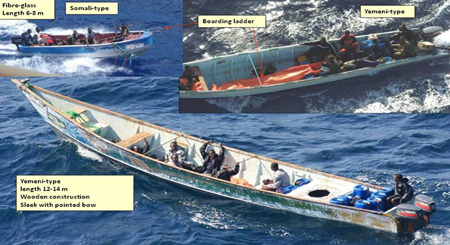- Boat
- Articles
- About
- Tehani-li Logs
- 2004
- Uligan Maldives
- Man, Oh Man, Oman
- Eritrea: The Nicest Place You’ve Never Heard Of
- Cruising Notes: Oman to Eritrea – From Pirates to Cappucinos
- Old Testament Sudan
- Egypt: Legend, Myth and Reality
- Thoughts on Cruising the Red Sea
- Greece: Civilization Again
- Montenegro
- Malta
- Sardinia, Italy
- Barcelona, Spain
- 2003
- 2002
- 2001
- 2004
- Contact
How to Avoid Pirates

(Note: This article I wrote for the SSCA Bulletin. The SSCA is the Seven Seas Cruising Association and they publish a monthly “bulletin” of mostly useful ideas and trips submitted by various cruising members from around the world. I recommend joining: www.ssca.org).
“Pirate Alley”
Piracy has become a new concern for cruising yachts contemplating a circumnavigation as the most popular route takes you through two of the choke points where the pirates lurk: the Strait of Malacca and the even more notorious and colorfully named “Pirate Alley:” past Somalia through the Gulf of Aden. This evil stretch of water is 450 miles long and only just over 100 miles wide, leading you between a rock (Somalia) and a hard place (Yemen). As a yachtie, you don’t have to worry about the Strait of Malacca; those pirates currently prey on shipping and are harried by the Malaysian and Singaporean Navy and I can’t recall any incidences of attacks on passing yachts. Somalia is a completely different story. Having sailed past Somalia through the Gulf of Aden and up the Red Sea with my new wife on our honeymoon cruise in 2004, I would like to share some thoughts of what works and what doesn’t from someone who has gone that way and lived to tell the tale.
Then
From 2006 onward, it seems, the Somali pirates began kidnapping sailors. Before that time their tactics were mainly centered around the slave trade. Don’t be shocked, it still exists in the Muslim world and is going strong. People smuggling from Africa across the narrow Gulf of Aden to Yemen and then onward to inland villages or to Saudi Arabia is the common route. The pirates usually operated small life boats taken from larger ships which meant an inboard diesel engine that could push the boat along at 6-7 knots. Armed with machine guns, they crossed the Gulf often at night, severely overloaded with their dark and sweaty human cargo. We know this because sailors before us who were opportunistically “hit” reported the same scene repeatedly over a number of years. Mostly, after approaching a transiting yacht that they happened to stumble upon on their crossing, the pirates would board the vessel, hold the crew at gunpoint as they rifled through whatever valuables could be found down below and then depart. The whole procedure usually took 10-15 minutes. This was gravy for the pirates on top of their main business of people smuggling. Yachties were not “targeted,” nor were they hurt. At the time, I looked at the risk of being boarded small and the procedure as a “tax” for passing through their territory. We, like other cruisers then, would “hide” a small bag of cash in the nav station along with an old camera for the pirates to “find” hoping this would satisfy them and allow a swift departure. Also, in flat conditions our boat could do 8 knots meaning we might be able to outrun an overloaded life boat.
 And Now
And Now
Pokey life boats have been ditched for high powered speed boats and RPGs have been added to the arsenal. “Mother ships,” hijacked dhows or fishing boats, now carry the pirates thousands of miles into the Indian Ocean. Instead of people smuggling, the pirates are after bigger prey; oil tankers and yacht crews for ransom.
Why the change? The country of Somalia doesn’t exist. At over 2,000 miles, Somalia has the longest coastline in Africa and few opportunities for employment. Throw in no education and high birth rates; this is a perfect breeding ground for pirates. Recent studies of the problem estimate the annual earnings for your garden variety Somali pirate to approach $79,000. Compared to his buddies back home in a shack living on a buck-fifty a day and sleeping with the goats, this is a huge sum. The idea, promulgated in the uninformed international press that these predators are “environmentalists” protecting their fishing grounds from those who would plunder their rightful resources is silly, stupid and wrong. The pirates are young, drugged out on speed or qat, and with nothing to lose, are extremely dangerous parasites. They are after a quick kill – not fish!
According to the IMB (Int’l Maritime Bureau), piracy attacks in 2011 year to date are up 58% on last year. The IMB has an interesting “Live Piracy Map” here. NATO has a website with up to date information and maps of current scumbaggery here.
Both organizations report pirate activity is “intensifying” and “The threat of pirate attack is constant and difficult to predict.” How about the following for encouragement? “Despite the success gained by the anti piracy forces, (minimal, IMHO) pirates will continue their business and try to hijack any vessel of opportunity.“
This year alone, 625 people have been taken hostage. That is a lot of people living in horrible conditions, mostly forgotten. Eight have been killed at sea, including four unfortunate American sailors on the yacht “Quest.” A Danish family on “Ing” was kidnapped with three children on board (what were they thinking!!) and recently released after a large ransom was paid. (They have just given an interview where the father says, “It was the decision of my life I regret the most“). An elderly British couple on 38 foot “Lynn Rival,” Paul and Rachel Chandler, left the Seychelles, believing the water would be “too rough for pirates” and were immediately captured and taken to Somalia where they were kept separated in deplorable conditions for over a year before being ransomed last November. Most recently, the pirates have been shooting first and asking questions later. The level of violence has skyrocketed and the rules of the game have changed. Here is how to protect yourself.
Don’t Go
This is the best course of action. Trying to cross the Gulf of Aden now is playing Russian roulette with five bullets. It isn’t worth the risk. You can’t “avoid” the Somali coastline and stick close to Yemen thinking you are safe. Just last month the pirates stormed and captured an anchored ship at Salalah, Oman – a major yachtie staging point on the route, well past Yemen. They have even captured ships just off the west coast of India. Like flesh-eating bacteria, it won’t be long before piracy spreads all the way to the Malacca Strait, rendering the entire Indian Ocean off limits.
If you can’t be dissuaded, I would suggest going from Perth, Australia across the bottom of the IO to S. Africa. This is a long and rough passage of 4,250 miles but one with the best chance of avoiding the issue. Pirates have been active in the Mozambique Channel so you can’t round the top of Mad and safely go that way anymore.
If You Go
1) Don’t go in a convoy. This is the most controversial statement I am making, I know. Most people feel safer going in company of other boats. When we went, everyone had assembled in Salalah to prepare for the most dangerous part of the trip. Most elected to go in a convoy for “protection.” Let me ask you this, if the yacht next to you is hit with crazed pirates in a speed boat carrying RPGs, what are you going to do to help? Throw tomatoes? Being right next to them just means they can and will nail you too. Also, convoys can only move at the speed of the slowest member ensuring you spend FAR LONGER than you normally might crossing this patch of water. Convoys are also easier to spot, again increasing the likelihood of attack. I won’t even get into how hard it is to sail/motor in formation at night with different types of boats and varying skill levels of captains! The only benefit of a convoy is other boats might be able to alert NATO forces to your plight before they fall victims themselves. But by the time NATO arrives – if they do at all and hours later – you are already toast. We flew solo, dark and fast.
2) Go on a moonless night. Your enemy has GPS and radio but usually lack radar. They find you by listening to the radio and the pirates have spies on shore. Don’t tell anyone ashore in Oman or Yemen your plans. If you think you can trust the locals you are a fool not worth saving.
3) Make sure all lights are extinguished at night. Forget about Colregs. Nobody follows the rules anywhere in the developing world anyway. Keep radio silence and go fast. Bring extra fuel on board in jerry cans and floor it – there is no wind on this stretch. This presupposes your engine is reliable.
4) Leave the radio on and keep abreast of where NATO ships may be. If you communicate with them when they appear (in sight only), do so on low power VHF. We found they would not even respond to us when we passed right by them! Remember they are there to keep the oil flowing to Europe and Asia. Yachts are not their concern.
5) Most pirate attacks on yachts have happened at dawn. This may be changing, however, with the greater speed and reach of the enemy. A yacht at night even with no lights is still easy to see crossing the horizon. The pirates will change course to follow behind. The yacht is not so visible then and their assumption is you will keep course allowing them to attack as the sun rises behind making them invisible until it is too late. To reduce this possibility, change course 20 degrees two hours before dawn. Without radar, the pirates will continue following the same course and likely will not notice your course change. Inshallah, you, my fine infidel, will have vanished by sunrise.
Finally, as bad as this is try and keep an open attitude. I saw many captains absolutely incensed that pirates would prevent them from sailing “where they damn well pleased.” Honestly, it is not our “right” to sail the oceans, it is a privilege. Would you venture out to sea in a hurricane because it is your right? Until the Indian Ocean is cleansed of this virus, treating the scourge of piracy with the same level of prudence as dangerous weather is just good seamanship.

